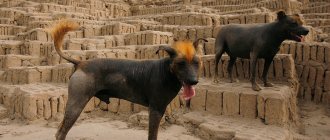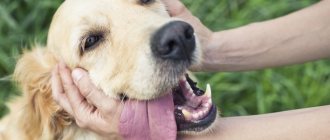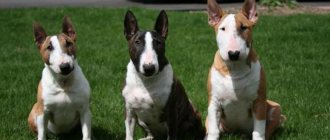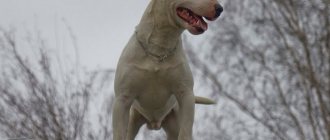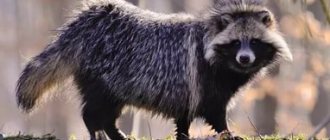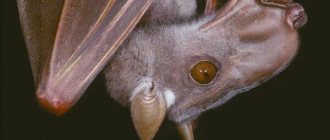Breed characteristics
| Short description | |
| Origin: | Mexico |
| Conditions of detention: | Apartment, house |
| Purpose: | Companion dog, guard dog |
| Color: | Brown, black, brindle, bronze |
| Wool length: | Complete or partial absence of hair, short, close-lying hair |
| Adult dog size: | Height:
Weight: 4-20 kg |
| Average life expectancy: | 12-15 years |
| Walk: | Mandatory two-time walk |
| Physical activity needs: | Average physical activity needs (1-1.5 hours of daily walks and games) |
| Fédération Cynologique Internationale (FIC) classification: | Group 5: Spitz and primitive breeds; Section 6: primitive rocks |
| Puppy price: | From 8 to 150 thousand rubles. Without pedigree - 3-10 thousand rubles, pet class - 20-35 thousand rubles, breed class - up to 100 thousand rubles, show class - 130 thousand rubles and above |
Description of the Xoloitzcuintle dog
According to the current standard, Xoloitzcuintles come in three sizes.
Mini 25-35cm
Average 36-45cm
Standard 46-60cm.
An important characteristic of the breed is the complete or almost complete absence of any hair and smooth, delicate skin. The Xoloitzcuintle's body has harmonious proportions, the chest is developed, the chest is wide, the legs and tail are long.
Leather
Due to the complete absence of hair, leather is of particular importance for this breed. It is smooth and very sensitive. The skin appears warmer than wool breeds because the heat is not filtered through the wool, but is transferred directly. Dogs with fair skin need more protection from the sun's rays. Accidental welts and scars should not be penalized by a reduction in the score when examining a dog at a show. The dog sweats through its paw pads and interdigital membranes and tends to pant.
Teeth
This breed lacks premolars (4 teeth following the canines). This is not a defect, but another distinctive feature of the breed, since the gene that determines the absence of hair is linked to the gene that determines the presence of teeth. Sometimes fangs are missing too.
History of the origin of the species
The record-breaking dog, Xolo, is a breed included in the Guinness Book of Records as the oldest and most indigenous breed. This means that the animals developed independently, without the intervention of breeders. There was a strict natural selection, during which only the strongest remained. Thanks to this development, Xolos are rewarded with almost impeccable health.
The name of the breed is closely related to the Aztec culture . In translation, Xoloitzcuintle is a messenger or dog of the god Xolotl (Xolotl), who rules the afterlife and the souls of the dead. That is why animals were considered conductors between the real and divine worlds. Pets were ritualistic, their figurines decorated temples, and the figurines were placed in the graves of the dead. One of the rituals involved killing and eating a dog. The Aztecs believed that Xolo could cure ailments.
According to archaeologists, the dog came to the continent along with British colonialists from the Coastal Strait. Lack of hair is a genetic mutation that did not harm the body and developed into a separate species.
During the existence of the Spanish invaders and their colonies, the Xolos were brutally destroyed. The Spanish government needed this to eradicate pagan culture and glorify Christianity. But the breed was preserved in remote villages.
In the 19th and 20th centuries, animals were popular among artists, the rich and the nobility. Frida Kahlo and her husband Diego Rivera even ran a small kennel and bred hairless Mexican dogs. In 1956, the Xoloitzcuintle was recognized in Mexico and spread throughout the world.
Now dogs are especially revered in their homeland; festivals and celebrations are held in their honor. And in 2022, the cartoon “The Secret of Coco” was released, where the Mexican naked became a symbol of devotion.
Theses
- Mexican Hairless dogs come in three sizes, so there is one to suit any home or apartment.
- They lived in Mesoamerica long before the arrival of Europeans.
- The litter contains both hairless and coated puppies. This is a normal feature of genetics.
- These are companion dogs, but they perform good guard duties.
- Due to the fact that they have no fur, the Xolo's skin feels hotter than other dogs. But their temperature is the same.
- There are about 30,000 Xolos in the world and 11,000 of them live in the United States. In Russia and the CIS countries they are represented quite well and have many fans.
- This is not a hypoallergenic breed, although the lack of hair significantly reduces the risk of allergies.
Distinctive features
The breed is often confused with the Chinese Crested. The animals are really similar: lean, dry body, absence (full or partial) of hair, long limbs, lean belly, sharp muzzle. Xolo has three height variations: mini (25-35 cm at the withers), medium or dwarf (36-45 cm), standard (46-60 cm). Depending on its height, a dog can weigh from 4 to 20 kg.
- The head is narrow, medium-sized, wedge-shaped with a flat forehead and a rounded crown, the stop is clearly expressed.
- The muzzle is proportional to the size of the head, the cheeks are flat, the bridge of the nose is straight, the lips are well pigmented and fit tightly to the jaws. Scissor bite The jaw bones are strong, but not wide.
- The nose is large and rectangular. The color depends on the color of the skin.
- The eyes are set high and wide, medium-sized, almond-shaped. Preferred dark iris color;
- The ears are set high, large, pointed;
- The body is elongated, elegant, strong. The topline is curved, the loin is convex, the croup is sloping. The chest is of medium volume, the stomach is lean.
- The tail is long and mobile. In a calm state it hangs down and reaches the hock joint, in an active state it rises above the lumbar line. Thick at the base, tapering towards the end.
- The limbs are straight and parallel, thin but muscular. The paws are elongated, similar to those of a hare.
- The coat is completely absent; there may be patches of fur on the scruff of the neck, tip of the tail and back of the limbs. The hair is thin, fluffy, of medium length. The skin is elastic and gathers in folds only on the muzzle.
- Color : brown, black, brindle, bronze.
Health
Xoloitzcuintle is a breed that appeared thanks to nature, so these dogs are distinguished by good health, endurance and strong immunity. With proper care, a sholo can live 12-15 years.
In order for the dog to get sick less often, the owner must carry out timely vaccinations, routine examinations in the clinic and treatment for internal and external parasites. It is also important to know what diseases representatives of the Xoloitzcuintle breed are predisposed to:
- Allergies – Xolos often experience allergic reactions to new foods or skin care products introduced into their diet.
- Skin diseases - in the Xoloitzcuintle, sweat comes out through the paws; if not properly cared for, this feature can cause the dog's skin to become covered with a foul-smelling coating. In this case, you must urgently contact a veterinarian; if no measures are taken, serious problems with the skin may arise.
- Problems with teeth - early loss, tartar, caries.
- Injuries – the lack of fur contributes to injuries during walks and active games.
- Obesity – occurs due to lack of exercise and overeating.
Photo of an adult dog
Photos of puppies
Features of character and behavior
In fact, the breed is intended for security service. Tall individuals are often used precisely for these purposes. But now Mexican Nakeds often act as companions and family friends. They are distrustful of strangers and can be aggressive towards other dogs, but they love and value their owners.
Advantages
- The breed is active and playful. Dogs love to spend time with their family, quickly become attached to people, and adapt to their owner’s mood. Contact with the owner is important for them, because in ancient times they directly depended on human will.
- Xoloitzcuintles get along well with children and the elderly ; the animals are not intrusive and do not require constant training. Gets along well with other animals, provided that they are properly socialized.
- Pets are smart, quickly respond to commands, and are easy to train. They are happy to constantly follow their owner, accompany him on trips, and give him positivity.
Flaws
- Indeed, a guard dog is distrustful of strangers, can show aggression, bark loudly, defending the territory. Therefore, Xolo, like no other, requires proper timely socialization.
- Pets tend to dominate, both within the family and with animals. They often get into fights to prove their superiority.
- Like all native breeds, Mexican Hairless are quite willful, so they can be stubborn. They often choose one leader in the family and listen only to him. To prevent this from happening, all members of the household should take turns taking care of the dog’s upbringing and hygiene.
Education and socialization
There are several reasons confirming the good training ability of such a dog. Firstly, nature has blessed him with an excellent memory, and secondly, he is very smart. However, the animal is quite capricious and strives, at all costs, to maintain its independence.
A puppy of this breed can be taught obedience, but this requires endurance and perseverance from the owner. Observe the animal as it settles into your home. You should not allow him to climb the wires, sniff the food on the table, or behave too intrusively. A dog prone to dominance must be taught discipline from an early age. Otherwise, she will grow up suspicious and distrustful.
Practice shows that almost no one has problems raising a Mexican naked. She is outgoing and friendly, loves human company and rarely bullies animals. But, if conflicts with her participation still periodically break out, measures will have to be taken.
Follow the development of events in the dog pack and identify the instigator. If your bald friend is your friend, grab him by the withers and then turn him over onto his back. Let other dogs sniff his tail.
This procedure is not sadistic at all, but absolutely humane. Thus, the status of the animal in the group is reduced to an acceptable limit. After this, it becomes less cocky, but more inclined to obey.
Training a Xoloitzcuintle requires kindness and moderate severity.
If your pet barks for no reason, it's bad. He probably does this out of boredom. Then he should just take some time, for example, go for a walk together or go play in nature. New experiences are extremely important for the socialization of such a dog. He will grow up closed and limited if his horizons are not systematically expanded.
An important rule is that a domestic dog should come at the first call of its owner. If this does not happen, she is clearly trying to dominate, that is, she does not respect you. How to teach her obedience and respect?
It is enough to spend at least 4 hours a day together, educate and always reward for efforts and good behavior. Remember that in raising a four-legged pet, 2 methods should be used: carrot and stick.
Care and maintenance
The breed is a dream for those who do not have the opportunity or desire to deal with wool on carpets and furniture. Dogs do not need to be combed, bathed often, or monitor the condition of the coat. But caring for Xolo has its own nuances. First of all, this is sensitive skin. Animals are also very sensitive to poor quality or improper nutrition. It is important to maintain the desired temperature regime, not to overcool your pet or overheat.
Nutrition
It is important for animals like Xolo to choose their diet wisely, taking into account possible allergic reactions. It is believed that the most common problematic foods are corn, chicken, potatoes, sweets, cereals and grains. These are the ingredients you should avoid when choosing dry food.
When a puppy is purchased, the breeder offers to continue feeding the dog the same product that was fed at the kennel. If the owner wants to switch the pet to natural food or another brand, then you need to consult a veterinarian and make the transition smoothly, gradually mixing the new food into the usual one.
Ready-made products are now particularly popular among dog breeders. After all, it’s convenient to calculate them; you don’t need to bother with preparation. Also, the granules contain all the necessary vitamins. But this only applies to good super-premium food and holistic food. For Xolo, a hypoallergenic product with a low content of grains and cereals should be selected.
- Natural nutrition should consist of 30-50% protein : lean meat (except chicken and pork), eggs (2 times a week), fermented milk products (cottage cheese and kefir), river fish.
- Carbohydrates are also needed in the diet . Your pet can get them from complex cereals (rice, buckwheat) and vegetables (carrots, beets).
The number of meals depends on age. Up to 2 months the animal is fed 5-6 times , from 2 to 4 - 4-5 times , by the year the dog is transferred to twice feeding. Serving size is determined individually based on weight and daily activity.
Under no circumstances should the diet contain bones, fatty, smoked, fried foods, sweets and flour, hot and spicy foods. Food for the pet is prepared separately; Xolo cannot be fed from the table.
We recommend that you read a detailed article on the topic: “How and what to feed a dog: types and characteristics of nutrition.”
Health
Xolos are strong, hardy dogs with developed immunity and resistance to changes in the environment. Despite this, animals remain allergic and often suffer from dermatitis and other problems with the epidermis. They live 12-15 years . Like other pets, Mexican Hairless cats require vaccinations and annual checkups with a veterinarian.
Vaccinations
All dogs must be vaccinated against dangerous infectious diseases . Basic vaccinations are carried out annually. In the first year of life, the course of repetitions is the widest.
- The first vaccination is given to puppies at 2.5 months ; the injection contains inactive strains of canine distemper, enteritis, leptospirosis, and salmonellosis.
- Revaccination is carried out after 2 weeks, at 6 months, at 12 months.
- Repetition is carried out either annually or once every 2-3 years (depending on the drug).
- The rabies vaccination is given at 7 months and repeated every year .
This is especially important if the pet actively interacts with wild or stray animals. Without the necessary vaccinations and marks in the veterinary passport, the animal cannot be transported across the border.
2 weeks before vaccination, the dog is dewormed. Walking your pet before the procedure is prohibited. It is also important to undergo quarantine (14-21 days after). At this time, it is not recommended to communicate with other pets, treat with antibiotics or strong active substances. In case of an allergic reaction (vomiting, lethargy for more than 2 days, apathy, high temperature), you should contact a veterinarian.
Important article on the topic: “Everything you need to know about dog vaccinations.”
Diseases
Diseases characteristic of the breed:
- Gastritis and indigestion;
- Food poisoning;
- Allergic reactions;
- Dermatitis;
- Sunburn;
- Hypothermia and colds;
- Dental problems;
- Rashes and acne.
Despite the fact that pets are considered not problematic, their skin needs special careful care. Considered hypoallergenic, dogs often have allergies to certain foods. In general, problems can be avoided with proper care, feeding, and hygiene standards.
Walk
The breed is active and willful; pets love to go for long and fun walks. They do not need serious physical activity and constant training, but walking should be regular - 2 times a day for 1-1.5 hours. The dog needs to release its energy, meet other animals, and socialize properly.
From the age of 2-3 months, the pet is introduced to the street, shown various public places, transport, and dog parks. It is important to teach your puppy to be tolerant of his environment so that he does not react aggressively or timidly.
Xolos can be walked without a leash only if they are completely obedient. Despite the fact that the animal is devoted to its family, due to its natural curiosity, the pet can run away and get lost from sight.
Grooming
Since these dogs have no hair at all (or only some hair), they are easy to care for. Brush them with a soft brush once a week , wipe them with a damp cloth if they are heavily soiled. It is recommended to bathe no more than 2 times a year ; in winter this procedure is avoided.
It is important not to let your pet be in a draft. During the cold season and wet rainy weather, Xolo is dressed in special protective overalls. In sunny weather, moisturize the skin with sunscreen lotions to prevent burns.
Pets' teeth are brushed 2 times a week, and nails are trimmed as they grow. During the period of growth and formation of the ears, you need to ensure that they are positioned correctly. Often, owners have to fix the cartilage with adhesives.
Possible diseases and methods of treating them
The most dangerous illness for Xoloitzcuintles is food allergies. Unfortunately, almost all representatives of the breed are prone to it. If this disease is present, the animal experiences the following symptoms:
- Itching.
- Redness of the skin.
- Nausea, possibly vomiting.
- Weakness.
- Increased tear production.
- Difficulty breathing, swelling of the nasopharynx.
Vaccinations given to your dog as a puppy will help reduce the risk of allergies. But, in order to definitely prevent its occurrence, do not give your pet food from the table, especially heat-treated food.
Since this Mexican breed has no fur, they are susceptible to dermatitis, a common skin condition. As it develops, the animal experiences severe itching.
The integrity of its skin is also partially compromised. The disease is provoked by poor diet and lack of hygiene procedures. Dermatitis in dogs, like food allergies, can only be treated by a veterinarian.
Well, the last thing that should be highlighted is limb injuries. The Xoloitzcuintle gets them often, especially during active games. Therefore, to minimize the risk of injury, do not throw objects high and far to your dog so that he does not have to quickly chase them, much less push off the ground to jump.
Mating
As with all dogs, there are optimal times for mating for Xolos. It is important to know that pets cannot be reduced until their 3rd heat, approximately 2-2.5 years. Males are allowed to breed at 25-30 months . By this age, animals are fully formed and can conceive and give birth to healthy offspring.
After the female starts estrus, you need to count 10-13 days. This period of time is ovulation. Then the girl appears in a playful mood, she accepts the male, the loop increases in size, and the discharge changes its color to light or light yellow.
Mating can be carried out on neutral territory or at the dog’s home. There the boy will feel relaxed. Pets are given 5-10 minutes to get acquainted. After the boy makes the cage, the animals need to be helped to find a comfortable position. Usually the girl is held by the head and under the belly, and the male is guided into the noose.
Read a detailed article on the topic: “Everything you need to know about breeding dogs: appropriate age, what to do if it doesn’t work out, rules and tips.”
The act lasts 10-15 minutes. The ideal ending would be a castle in which the dogs stand for 5-7 minutes . But pregnancy can happen even without a lock. Repeat mating after 48 hours to be on the safe side. After 2 weeks, the first signs of pregnancy may appear: toxicosis, restlessness, changes in behavior.
Reproduction and lifespan
These are not easy dogs, and there are a lot of requirements for their breed. Experienced breeders always organize their mating according to the following rules:
- Only mature females and males (over 2 years old) are selected.
- Excluded from breeding are older individuals (those older than 6-7 years).
- A place is being prepared for mating of a female with a male in his house.
- Waiting for the 3rd day of the bitch's heat.
- Do not interfere with the introduction of dogs.
- If it is unsuccessful, their meeting is rescheduled.
Xoloitzcuintle bitches are good and caring mothers. They extremely rarely refuse to feed their brood. They may do this due to the presence of a foreign odor on their body. Therefore, we strongly advise against holding newborn puppies on the first day.
If the bitch refuses to feed her puppies, you will have to help them gain weight. Use her expressed milk poured into a baby bottle with a nipple. Don't let babies overfeed! They must feed on mother's milk for at least 1 month, the optimal period is 2-3 months. These dogs live for about 14 years.
In a Xoloitzcuintle litter, one out of five puppies is always born with fur.
Key points in training
The breed is not difficult, despite its aboriginal origin . Xolo's abilities are aimed at cooperation with people, oriented towards family and surrounding people. They quickly remember commands and are rarely stubborn, but can be aggressive towards other people or animals. Therefore, your pet needs to be weaned off outbursts of negative emotions and uncontrolled antics.
The direction of training is chosen by the owner. He can contact special canine schools and take his pet through a training course with specialists. The main types of programs: general course (training commands, rules of behavior and relationships with the owner), agility (running with obstacles), freestyle (playing with a flying disc, developing muscles and reaction), flyball (chasing a ball with obstacles).
Read about how to properly train a dog in the article: “Training a puppy: effective methods from dog handlers, learning commands at home.”
They begin to raise puppies from an early age, explaining to them that they cannot go to the toilet at home, damage furniture, beg, or sleep in the owner’s place . The pet should know that a person is always the first to enter the house, and feeding takes place after the whole family has eaten. Training begins from 4 months , when the puppy gets used to the street and goes through the first stages of socialization.
How to choose a puppy
This is one of the rarest breeds and, despite the fact that dogs are quite popular in Mexico, in Europe and Asia it will be difficult to find a truly purebred individual. Therefore, it is important to select a kennel carefully, read the reviews of dog breeders in advance, and check the breeder’s documents. The fact is that Xolo is poorly adapted for the Central European climate, but with careful care the dog can survive any frost.
The breeder must tell everything about the content of the breed, show the parents and their pedigrees. Healthy puppies are always active, curious, and playful. It is important to learn about feeding in the nursery so as not to disrupt the gastrointestinal tract.
To choose a specific pet, you need to decide on the gender, size, age and desired color. In the first case, there are only 2 criteria: girls are usually more docile and obedient, boys are more active and willful. The size is determined by calculating the dimensions of the home, because such a dog is intended only for keeping indoors. The color depends only on the wishes of the future owner.
Experts recommend taking a puppy from its mother no earlier than 1.5-2 months, when the animal can already eat on its own. Such pets are easy to raise and accustom to the necessary routine, but they will require more care. Older dogs (5-6 months) do not require special attention, but it will be difficult for them to get used to the new regime.
The cost of a puppy of this breed directly depends on its class. Pets without documents can cost 8-10 thousand rubles, but the price for representatives of the winning dynasty reaches 100-150 thousand rubles.
Nutrition
The Xoloitzcuintle's diet should include high quality food. This breed's diet can include fruits and vegetables. Meat is a source of protein, which is incredibly important for the functioning of a dog’s body.
It should be low in fat. Dry dog food is also suitable. Since the dog does not have a full row of teeth, it is difficult for him to chew large pieces or bones. Therefore, large pieces of meat need to be chopped finely or simply ground into minced meat.
You can also feed canned dog food or balanced dry food. For the normal formation of teeth and bones of an animal, the diet must also include calcium.
Xoloitzcuintle in wool
This breed was considered a bad litter for a very long time. Xolo puppies born with fur were simply bred from a further breeding line. But even when mating naked individuals, whose ancestors were also naked, “woolen” puppies were born. Now this is explained simply, at the level of gene transmission. The hairless gene is dominant. But animals with two hairless genes do not survive, and animals with two fur genes are rare. Therefore, all bald pets carry the gene for short hair.
One way or another, smooth-haired Xolos were recognized only in 2007; before that, dogs were prohibited from participating in exhibitions and competitions. They were named Itzcuintli , and are completely covered with short, stiff hair, unlike the Xolo, which has a partial mane. Dogs are hypoallergenic because they have no undercoat and do not shed.
In all other respects, the breeds are identical: both in external parameters and in character.
If a child or family needs a faithful friend who will help in trouble and be there in joy, then the Xoloitzcuintle is an ideal option. Animals are suitable for families with small children, allergy sufferers, and elderly people. They are smart, loyal and kind. Like any dog, Xolo needs love and care, and therefore will require a lot of time.
5 / 5 ( 1 voice )
Character of the Xoloitzcuintle dog breed
These are calm, friendly and willful dogs. Xoloitzcuintle dogs require constant communication with household members, they feel comfortable in noisy families, and find a common language with older children. The greatest joy for a pet is to be close to its owner, which is why they can be intrusive. They obey all family members, but still identify a leader for themselves, who is considered the main one on the hierarchical ladder.
Nature has given the Mexicans excellent guard qualities, so a characteristic feature of the Xoloitzcuintle is suspicion of all strangers. Possessing a good sense of smell and hearing, they sense the approach of a stranger before he appears, and warn about this with a quiet bark or activity. They do not show aggression towards other animals; fights with fellow animals are possible if they are defending territory.
Xolos are big fans of active walks. Those who expect their pet to keep them company on the couch in front of the TV will be disappointed. Based on the peculiarities of the breed and character, Xoloitzcuintles can get along where they are not considered as a toy, but are perceived as intelligent, independent creatures, and are considered members of the family. For this reason, they should not be owned if there are small children in the house.

